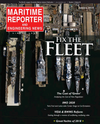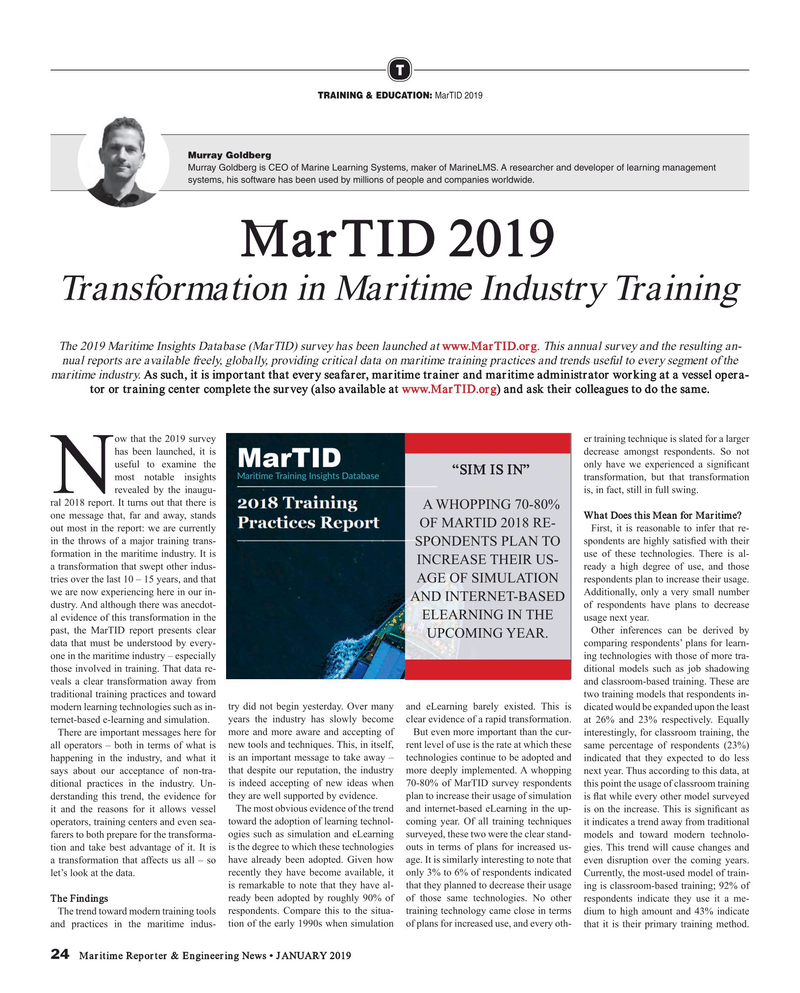
Page 24: of Maritime Reporter Magazine (January 2019)
Ship Repair & Conversion: The Shipyards
Read this page in Pdf, Flash or Html5 edition of January 2019 Maritime Reporter Magazine
T
TRAINING & EDUCATION: MarTID 2019
Murray Goldberg
Murray Goldberg is CEO of Marine Learning Systems, maker of MarineLMS. A researcher and developer of learning management systems, his software has been used by millions of people and companies worldwide.
MarTID 2019
Transformation in Maritime Industry Training
The 2019 Maritime Insights Database (MarTID) survey has been launched at www.MarTID.org. This annual survey and the resulting an- nual reports are available freely, globally, providing critical data on maritime training practices and trends useful to every segment of the maritime industry. As such, it is important that every seafarer, maritime trainer and maritime administrator working at a vessel opera- tor or training center complete the survey (also available at www.MarTID.org) and ask their colleagues to do the same. ow that the 2019 survey er training technique is slated for a larger has been launched, it is decrease amongst respondents. So not useful to examine the only have we experienced a signi? cant “SIM IS IN” most notable insights transformation, but that transformation
Nrevealed by the inaugu- is, in fact, still in full swing.
ral 2018 report. It turns out that there is
A WHOPPING 70-80% one message that, far and away, stands What Does this Mean for Maritime?
OF MARTID 2018 RE- out most in the report: we are currently First, it is reasonable to infer that re- in the throws of a major training trans- spondents are highly satis? ed with their
SPONDENTS PLAN TO formation in the maritime industry. It is use of these technologies. There is al-
INCREASE THEIR US- a transformation that swept other indus- ready a high degree of use, and those tries over the last 10 – 15 years, and that respondents plan to increase their usage.
AGE OF SIMULATION we are now experiencing here in our in- Additionally, only a very small number
AND INTERNET-BASED dustry. And although there was anecdot- of respondents have plans to decrease
ELEARNING IN THE al evidence of this transformation in the usage next year.
past, the MarTID report presents clear Other inferences can be derived by
UPCOMING YEAR.
data that must be understood by every- comparing respondents’ plans for learn- one in the maritime industry – especially ing technologies with those of more tra- those involved in training. That data re- ditional models such as job shadowing veals a clear transformation away from and classroom-based training. These are traditional training practices and toward two training models that respondents in- modern learning technologies such as in- try did not begin yesterday. Over many and eLearning barely existed. This is dicated would be expanded upon the least ternet-based e-learning and simulation. years the industry has slowly become clear evidence of a rapid transformation. at 26% and 23% respectively. Equally
There are important messages here for more and more aware and accepting of But even more important than the cur- interestingly, for classroom training, the all operators – both in terms of what is new tools and techniques. This, in itself, rent level of use is the rate at which these same percentage of respondents (23%) happening in the industry, and what it is an important message to take away – technologies continue to be adopted and indicated that they expected to do less says about our acceptance of non-tra- that despite our reputation, the industry more deeply implemented. A whopping next year. Thus according to this data, at ditional practices in the industry. Un- is indeed accepting of new ideas when 70-80% of MarTID survey respondents this point the usage of classroom training derstanding this trend, the evidence for they are well supported by evidence. plan to increase their usage of simulation is ? at while every other model surveyed it and the reasons for it allows vessel The most obvious evidence of the trend and internet-based eLearning in the up- is on the increase. This is signi? cant as operators, training centers and even sea- toward the adoption of learning technol- coming year. Of all training techniques it indicates a trend away from traditional farers to both prepare for the transforma- ogies such as simulation and eLearning surveyed, these two were the clear stand- models and toward modern technolo- tion and take best advantage of it. It is is the degree to which these technologies outs in terms of plans for increased us- gies. This trend will cause changes and a transformation that affects us all – so have already been adopted. Given how age. It is similarly interesting to note that even disruption over the coming years. let’s look at the data. recently they have become available, it only 3% to 6% of respondents indicated Currently, the most-used model of train- is remarkable to note that they have al- that they planned to decrease their usage ing is classroom-based training; 92% of
The Findings ready been adopted by roughly 90% of of those same technologies. No other respondents indicate they use it a me-
The trend toward modern training tools respondents. Compare this to the situa- training technology came close in terms dium to high amount and 43% indicate and practices in the maritime indus- tion of the early 1990s when simulation of plans for increased use, and every oth- that it is their primary training method. 24 Maritime Reporter & Engineering News • JANUARY 2019
MR #1 (18-25).indd 24 MR #1 (18-25).indd 24 1/11/2019 1:17:23 PM1/11/2019 1:17:23 PM

 23
23

 25
25
